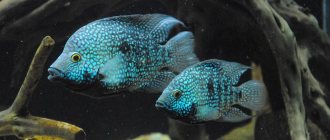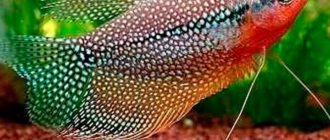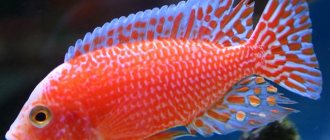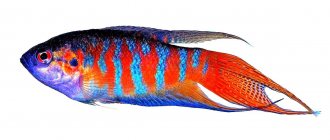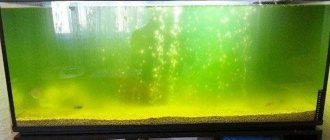What is the difference between females and males
Like many other fish species, this family also has representatives of both sexes, each with its own characteristic features. When breeding fish, it is worth considering that female and male angelfish have minor differences until they grow up to about 9-10 months. Only after this it becomes clear that the upper dorsal fin of males develops much more than that of females. In addition, many more stripes are visible on the back of the fin.
The difference between female and male angelfish is also in the frontal part of the head, since in the male it is convex, and in the female, on the contrary, it is concave.
Description of aquarium fish
Angelfish have a round body that is flattened at the sides. The anal and dorsal fins are long and give the fish a crescent shape. In nature, their body is silver with black transverse stripes. As a result of selection, many different colors were obtained: red, black, marbled, zebra, two-color, blue, pink and others.
Adults in a spacious aquarium grow quite large. The length of the fish reaches 15 cm, and the height is 25 cm. To make the fish comfortable, you need a large aquarium. So for a pair of scalars there should be 100 liters. In good conditions they live for about 10 years, or even more.
Determining the sex of an angelfish
Many aquarium fish owners wonder how to distinguish a female from a male angelfish, as this is very important for their breeding. Determining gender for a beginner is not such a simple task at first, because in the absence of experience and attention, it is almost impossible to determine their gender. An experienced aquarist will cope with the task without difficulty.
It is very difficult to do this if the fish have not yet reached sexual maturity. However, both sexes have certain characteristics by which their gender can be determined.
Features of the genital organs of fish
Angelfish are considered quite attractive and unusual inhabitants of the aquarium. Every owner of these amazing creatures should know how to distinguish a female from a male. You need to wait until the individuals grow a little and reach puberty, since after that they need some care.
To determine which angelfish is male and which is female, you need to examine their genitals. As soon as the fish becomes an adult, a small tube begins to be visible near its anus: in the female it is the ovipositor, and in the male it is the vas deferens. The reproductive organs are located behind the ventral paired fins and become more visible during spawning. To better examine the genitals of the fish, it is necessary to transplant it into a separate aquarium.
The gender of a fish can also be determined by the shape of its genitals. In males, the vas deferens has the shape of a pointed narrow tube that looks like the tip of a pencil. In the female, the ovipositor has a cylindrical and more rounded shape.
Differences in body shape
If you are concerned about the question of how to distinguish a female from a male angelfish, then you need to inspect the body of the fish. It is necessary to pay attention to the protruding growth on the forehead of males. This makes his forehead noticeably larger and more expressive. The fatty growth becomes more noticeable in adults, but the first signs become noticeable already at an early stage of development.
In addition, it is very important to note the smaller size and much more rounded body shape of females. If you need to purchase several pairs of fish for further reproduction, then it is important to select a pair of small and a pair of large individuals.
Differences in gender behavior
Many people wonder how to distinguish a female from a male angelfish based on the behavior of the fish. During the breeding season, angelfish, which generally lead a gregarious lifestyle, choose only one partner and create pairs. Even a beginner can identify an already formed “family”. The pair stays separately and looks for the most suitable place for laying eggs.
By nature, these amazing aquarium fish are monogamous. The loss of a partner as a result of separation from him or death is a huge stress for fish, which they often may not survive. Angelfish can injure themselves by hitting the walls of the aquarium or objects located in it, which leads to their death. This is why you can select partners for fish, but you should not destroy already formed pairs.
General information
Angelfish, whose reproduction fascinates owners, belong to the cichlid family and are caring parents. The homeland of the phenotype is South America; a characteristic feature of the angelfish is considered to be a disc-shaped body shape, which is why the phenotype received the name “angel”. In aquarium conditions, angelfish grow 15-26 cm in length, and under favorable conditions they live up to 10 years. However, this is not the limit - in the aquarium hobby, long-livers have been recorded that lasted up to 20 years.
The keeping of these South American cichlids began in 1911, and the first successful breeding in a community aquarium occurred in 1914. The success was repeated a year later by the American expert W. L. Polin. How fish reproduced was known only in Europe: the reasons for angelfish to lay eggs were kept secret. For a long time, Russian aquarists were unable to reproduce from angelfish, and it seemed that the long-awaited fry could not be obtained. A happy accident helped: aquarist A. Smirnov, while trying to spawn an angelfish, forgot to turn off the heater for the tank, as a result of which the temperature of the liquid increased to 32C. This led to the fact that the fish began to reproduce, and the conditions of reproduction were no longer a secret.
Nowadays, breeding angelfish in a general aquarium or a hatchery is not difficult: cichlids spawn independently, and spawning occurs frequently. However, in order to raise and preserve the eggs, aquarists have to take care of the fry themselves.
Typically, reproduction is divided into four stages:
- Mate selection and sex differences.
- Preparation.
- Spawning.
- Growing.
Sex determination during spawning
To accurately determine the sex of angelfish during spawning, you need to place a group of several mature individuals in a separate aquarium. When purchasing fish, it is best to buy 4-6 young fish at once and place them together. However, you need to select a large enough aquarium for the angelfish to feel comfortable. When selecting fish, it is advisable to purchase several small and larger individuals, as this will increase the likelihood of acquiring angelfish of different sexes, and hence the subsequent formation of spawning pairs.
To determine the sex of fish, you need to monitor the behavior of spawning individuals. When they reach puberty, they will begin to form pairs on their own and then spawn. From now on, you need to carefully monitor the behavior of the fish, as this will allow you not only to determine their gender, but also to understand exactly how they are distributed into pairs.
However, we must remember that individuals of the same sex can also form pairs; naturally, they will not have offspring. Sometimes spawning pairs show signs of attention, which can be affectionate and touching or somewhat aggressive.
With careful observation, you can notice that the female is laying eggs, but you will have to spend a lot of time at the aquarium so as not to miss the moment.
It is worth noting that the older the angelfish becomes, the easier it is to determine its gender, since at an older age the genitals drop lower, which makes it possible to clearly see them.
Conditions of detention
Comfortable water temperature for rolling pins is 22-27 degrees. But despite this, fish can survive at temperatures of 16 degrees. They tolerate temperature rises up to 35 degrees well. As for water parameters, they can live in both soft and hard water. But dH is considered more comfortable: up to 10°, Ph: 6-7.5.
To live comfortably in an aquarium, you must install a filter and an aerator. Every week you should change 30% of the water to fresh.
It is not necessary to cover the aquarium with a cover glass or lid. Angelfish are inactive and will not jump out of the water.
As for lighting, it should be moderate. It is very good if plants float on the surface, for example, hornwort, pistia, riccia. If the light is bright, the fish will hide and get scared. In the aquarium, plant long-stemmed plants, such as spiral vallisneria, ludwigia, and bacopa. This aquarium imitates the natural habitat of cichlids.
Angelfish do not need driftwood, stones, or grottoes, but they can be used as decorations. When decorating the jar, be sure to leave an open space for floating.
It is better to keep angelfish in a flock. Strong and large couples will dominate, and the rest will hide from them.
Spawning process
Often, angelfish begin to lay eggs in the afternoon, towards evening. The entire spawning process takes very little time and lasts approximately 1.5 hours. At this time, the female presses almost closely to the surface of the aquarium and lays eggs in even rows. At the same time, the male repeats all the movements of his partner and thereby fertilizes the eggs. When spawning an angelfish, it is important to know how to distinguish a female from a male. Photos of fish will allow you to take a closer look at gender differences.
Provided the eggs are quickly collected and transferred to another vessel, angelfish can spawn every 2 weeks. They can do this in a common aquarium, but for successful rearing of offspring it is important to provide them with separate free space. This must be done in order to protect the clutch from encroachment by other inhabitants of the aquarium, since there is no guarantee that the spawning pair will be able to provide the required protection to the clutch. In addition, if the larvae and fry live in a common aquarium, it will be almost impossible to preserve them.
To avoid infecting the fry with various kinds of diseases, you need to add certain drugs to the water that will help destroy all fungi and bacteria. It is important to remember that caviar needs constant access to oxygen, which is why it needs to be placed at a short distance from the aerator, but in such a way that air bubbles do not fall on it.
Breeding
Angelfish are monogamous fish. At sexual maturity, which occurs at 10-12 months, they themselves choose a mate with whom they remain for the rest of their lives. At the time of spawning, the couple must be kept together, since the male is ready to fertilize eggs only in the presence of the female.
As mentioned above, it is recommended to transfer fish from a community aquarium to a spawning tank (with a slightly elevated water temperature) to avoid aggression towards other pets. Neighbors can also enjoy caviar. Otherwise, spawning takes place in the same aquarium. The female lays eggs on a wide flat stone or broad-leaved plant, previously cleared of debris. At the same time, the male is engaged in fertilization. In one process, the female is capable of laying up to 700 eggs. Angelfish are caring parents. They carefully fan the eggs with their fins and remove unfertilized eggs.
However, unexpected behavior also happens. If the aquarist notices that the parents are eating eggs, an urgent need to place a leaf or stone in an incubator container under the following conditions:
- Temperature 30 degrees Celsius;
- Water level – 15 cm;
- Hardness and acidity within a community aquarium.
When transferring, angelfish eggs should not come into contact with air.
After a couple of days, the larvae hatch. The couple carefully transfers them to a new stone or leaf so that the remaining shell does not infect the babies. For another week, the larvae are attached to the new place by gluten and feed from the yolk sac. Then the formed fry set off for free swimming.
Artemia nauplii or ready-made baby food, previously ground to a finer fraction, are suitable as starter food. At first, babies are fed up to 6 times a day. Over time, the number of feedings decreases.
After a month and a half, the fish take on the appearance and shape that is familiar to us.
Video: Angelfish from eggs to fry

